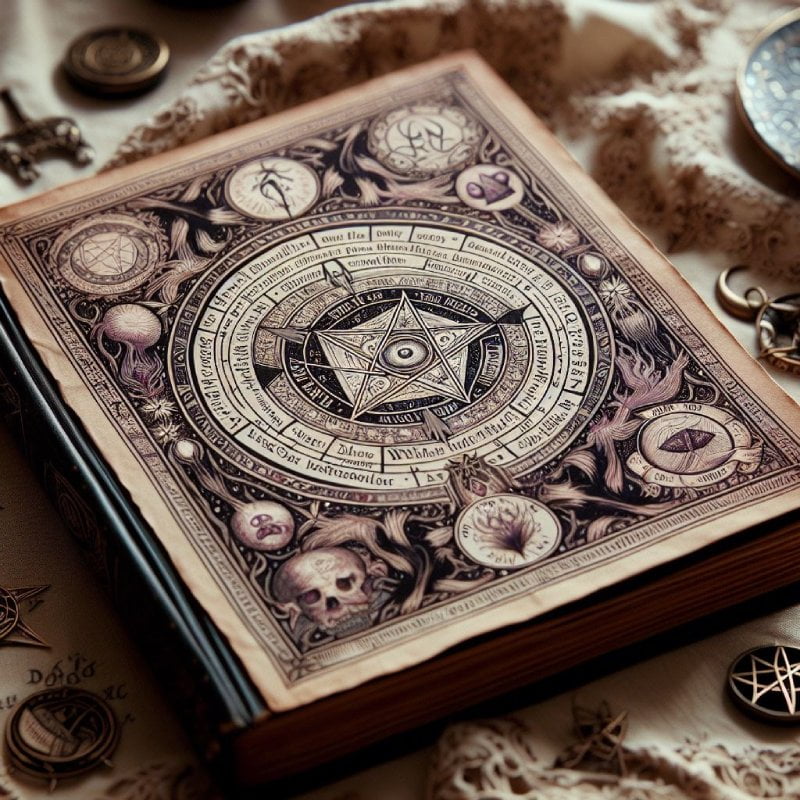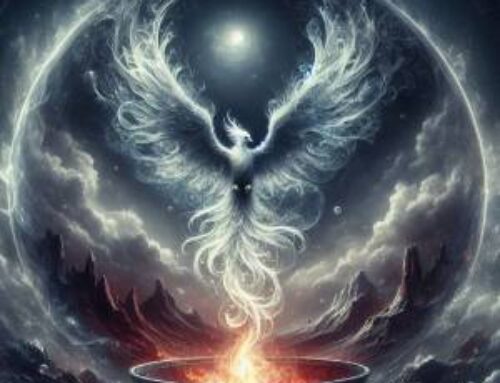Contents
- 1 Introduction to Laws of Magick
- 2 Understanding the Foundations of Magick
- 3 The Hermetic Laws and Magickal Practice
- 4 The Role of Consciousness in Magick
- 5 Conclusion
- 6 FAQ – Laws of Magick
- 6.1 1. How do the Hermetic principles within the laws of magick influence magickal practice?
- 6.2 2. What is the significance of consciousness in applying the laws of magick?
- 6.3 3. Who can effectively learn and apply the laws of magick?
- 6.4 4. How do ethical considerations impact the practice of the laws of magick?
- 7 References
Introduction to Laws of Magick
In the mystical corridors of the unseen, the laws of magick stand as ancient codices, etching the pathways through which the invisible forces of the universe operate. These are not mere guidelines but the foundational pillars that underpin a profound practice distinguishing true magick from the mere illusions of parlor tricks and stage magic. These deep, immutable principles guide the adept from the physical realm into the metaphysical, offering a gateway to understanding the intricacies of reality itself.

The study of the laws of magick involves a profound exploration into a world where every action and thought is intertwined with cosmic forces. This arcane knowledge, rooted in traditions such as Hermeticism, Kabbalah, and other esoteric schools, provides practitioners with the tools to influence their surroundings in ways that transcend ordinary understanding.
By understanding these laws, magicians embark on a quest not just of power, but of wisdom and self-realization. Each law acts as a thread in the vast tapestry of the universe, and learning to see and manipulate these threads can lead to insights into the nature of all things. This article invites you on an exploration of these profound laws, unraveling their mysteries and revealing their practical applications in the transformative practice of magick (1).
Understanding the Foundations of Magick
The Nature of Universal Connectivity
One of the cornerstone principles in the study of the laws of magick is the inherent interconnectedness of all things within the universe.
“All things are from One and by the One; and unto One all things are made.” (2)
This foundational law asserts that each thought, action, and occurrence is intricately woven into the fabric of the cosmos, affecting not just the practitioner but the broader energetic field. By embracing this interconnected nature, magicians can align their practices with the natural order, optimizing the effectiveness and harmony of their magical workings.
Material and Spiritual Continuum
The laws of magick elucidate the seamless continuum between the physical and the spiritual realms. Practitioners of magick understand that these realms are not separate but are interconnected layers of existence, each influencing the other. This law invites magicians to navigate these dimensions with the precision and acumen of a skilled traveler, using their understanding to manipulate subtle energies that manifest real-world changes.
Magic versus Magick
The distinction between “magic” and “magick” is crucial in the esoteric and hermetic traditions where “magick” specifically refers to the practice of harnessing and directing supernatural forces to influence reality, aligning with the spiritual laws discussed. Conversely, “magic” often refers to the art of illusion or sleight of hand performed for entertainment. This differentiation is vital for practitioners and scholars alike, as it respects the profound spiritual and transformative aspirations of magick, setting it apart from the entertainment-focused aspects of magic. Although the spelling magic is correct, we use the popular spelling magick in this article.
Practical Application and Ethical Considerations
Beyond theoretical understanding, the laws of magick require a practical and ethical application. These laws are not just tools for personal gain but guidelines for restoring and maintaining cosmic balance. The ethical practitioner of magick views their abilities as a means to serve the greater good, fostering healing, protection, and positive transformation. This approach ensures that their magical work not only adheres to the spiritual laws but also contributes to the well-being of the wider community.
The Hermetic Laws and Magickal Practice
Transmutation and the Hermetic Path
At the core of Hermetic teachings lies the profound process of transmutation, which is seen as a path from the material to the spiritual, embodying the magic of light. This transformation is fundamental to Hermeticism, guiding practitioners in their spiritual journeys. It is through the art of transmutation that one achieves the Great Work or the Philosopher’s Stone, symbolizing ultimate enlightenment and the manifestation of divine essence in the material world.
The Principle of Vibration and Magickal Alignment
Hermeticism emphasizes the Principle of Vibration, which teaches that everything in existence moves and vibrates at its own frequency. For magicians, understanding and aligning with these frequencies is crucial for effective magickal work. This alignment involves the meticulous planning and execution of rituals that consider astrological conditions and the specific energetic qualities of the time, thereby enhancing the practitioner’s connection to universal forces.
The Ethical Application of Hermetic Laws
Hermetic magick is not merely about personal gain but encompasses a broader ethical dimension. It stresses the restoration and maintenance of cosmic balance. Practitioners are viewed as stewards of spiritual power, tasked with using their knowledge for the betterment of all, thus contributing to the collective evolution of consciousness. This perspective frames the magickal work as a service to the greater good, ensuring that actions are aligned with the universal laws of harmony and balance.
Integration into Daily Practice
The application of Hermetic principles extends beyond formal rituals into the everyday lives of practitioners. It involves a continuous practice of reflection and meditation, aimed at deepening the understanding of the interconnectedness between the inner life and the outer reality. This daily integration helps cultivate a lived reality where magickal principles are manifest, leading to a more conscious and enlightened existence.
Spiritual journeying is a lifelong process that involves exploring one’s inner self and a larger cosmic consciousness, often leading to transformational experiences and assisting others in healing processes (3).
The Role of Consciousness in Magick
Consciousness as the Transformative Power
Consciousness in magick is not just a passive observer but the very crux of transformation. The Magician card in the Tarot symbolizes this, where attention and concentration are not just acts of the mind but transformative powers that align the magician’s environment with the Universal Mind. This alignment allows the magician to perceive and interact with the world not as it appears, but as it truly is—a fundamental aspect of magickal practice.
Superconsciousness and Manifestation
The role of the superconscious mind is pivotal in magick, where it channels through the practitioner to manifest desired changes. By directing this superconscious energy consciously, magicians harness the ability to influence their reality profoundly. This practice underscores the importance of aligning one’s will with the universal will, thereby acting not out of personal desire but as an agent of the divine will.
Subconscious Symbols and Magickal Practice
The subconscious mind, rich with symbols and archetypal images, serves as a fertile ground where magickal intents are seeded. In magick, these symbols are not merely representative but are functional tools that, when employed correctly, have the power to alter reality at its core. This interaction between the magician’s focused intent and the subconscious symbolism is what actualizes magickal outcomes.
Practical Applications and Ethical Considerations
Incorporating these dimensions of consciousness into daily practice amplifies the magician’s ability to operate within both the seen and unseen worlds. Ethically, this power must be wielded with a deep sense of responsibility, as each act of magick contributes to the balance or imbalance of broader cosmic rhythms. Thus, magicians are guided not only by the knowledge of how to perform magick but also by a strong moral compass that aligns their actions with universal harmony.
Conclusion
Through this detailed exploration of the laws of magick, we have uncovered the foundational principles that distinguish the profound practice of magick from mere illusion. From understanding the interconnected nature of the universe and the continuum between the material and the spiritual, to recognizing the pivotal role of consciousness in shaping reality, the laws of magick offer a comprehensive framework for navigating the mystical landscape of the unseen.
As we have seen, the Hermetic laws, such as the Principle of Vibration and the Law of Polarity, provide magicians with the knowledge to manipulate and balance energies, ensuring that their practices are both effective and harmonious. These principles are not just theoretical concepts but are applied through rituals and daily practices that align personal intentions with universal energies.
In embracing these ancient yet timeless wisdoms, practitioners of magick are called to a higher standard of ethical responsibility—using their powers for the greater good and contributing to the cosmic balance. This path is not for the faint-hearted but for those who dare to tap into the deep currents of magickal tradition and use this knowledge to transform themselves and the world around them.
Enter the Magickal Path of Light
For those who wish to delve deeper into these mystic arts, the Hermetic Academy offers a wealth of resources and teachings to guide you on your magickal journey, ensuring that every step you take is informed by wisdom and insight into the eternal laws of magick.
FAQ – Laws of Magick
1. How do the Hermetic principles within the laws of magick influence magickal practice?
A: Hermetic principles, essential components of the laws of magick, guide practitioners in synchronizing their actions with universal energies. By applying the Principle of Vibration and the Law of Polarity, magicians ensure their practices align with natural dynamics, facilitating effective magickal outcomes in harmony with the cosmic order.
2. What is the significance of consciousness in applying the laws of magick?
A: Consciousness serves as a transformative element under the laws of magick, enabling practitioners to actively shape reality. This involves using heightened awareness and focused intent to manipulate energies, adhering to the laws of magick that govern the subtle interactions between the spiritual and material realms.
3. Who can effectively learn and apply the laws of magick?
A: Not everyone is capable of learning and effectively applying the laws of magick. This discipline requires a deep understanding, innate sensitivity to spiritual energies, and a commitment to ethical practice. Those who pursue learning the laws of magick typically do so under guided instruction, such as that provided by institutions like the Hermetic Academy, to ensure a correct and responsible approach.
4. How do ethical considerations impact the practice of the laws of magick?
A: Ethical considerations are paramount in the practice of the laws of magick, ensuring that actions taken by magicians contribute positively to universal balance. Practitioners must wield their knowledge responsibly, using the laws of magick to promote healing, balance, and beneficial transformation, rather than for harm or personal gain.
References
(1) Rubenstein, E. (2023). Magic: The Legacy of the Rosicrucians. Hermetic World, Paphos.
(2) Ficino, M. (1471). Corpus Hermeticum. Florenz.
(3) Keegan, L. (1991). Spiritual Journeying. Journal of Holistic Nursing, 9, 14 – 3. https://doi.org/10.1177/089801019100900103.





